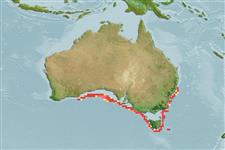Klassifizierung / Names
Namen | Synonyme | Catalog of Fishes(Gattung, Arten) | ITIS | CoL | WoRMS | Cloffa
Elasmobranchii (Haie und Rochen) (sharks and rays) >
Rajiformes (Skates and rays) >
Rajidae (Skates)
Etymology: Dipturus: Greek, di = two + Greek, pteryx = fin (Ref. 45335); acrobelus: Name from Greek 'acrobeles' for arrow or pointed at the end; refers to its long, angular snout and somewhat arrow-head shaped body..
More on authors: Last, White & Pogonoski.
Environment: milieu / climate zone / depth range / distribution range
Ökologie
seewasser bathydemersal; tiefenbereich 446 - 1328 m (Ref. 75649), usually 800 - 1000 m (Ref. 114953). Deep-water; 31°S - 46°S, 123°E - 154°E (Ref. 114953)
Indo-West Pacific: southern Australia.
Size / Gewicht / Alter
Maturity: Lm ? range ? - ? cm
Max length : 95.0 cm TL Männchen/unbestimmt; (Ref. 75649); 137.1 cm TL (female)
Inhabits upper and mid-continental slope (Ref. 114953). Observed lengths for adolescent males, between 77.6 and ca. 85.5 cm TL and smallest juvenile 20.2 cm TL (ref. 75649).
Life cycle and mating behavior
Geschlechtsreife | Fortpflanzung | Ablaichen | Eier | Fecundity | Larven
Last, P.R., W.T. White and J.J. Pogonoski, 2008. New skates of the genus Dipturus (Rajoidei: Rajidae) from Australian Seas. pp. 9-52. In Last, P.R., W.T. White, J.J. Pogonoski and D.C. Gledhill (eds.): Descriptions of new Australian skates (Batoidea: Rajoidei) pg. 9-51. CSIRO marine and atmospheric reseach paper no. 021. (Ref. 75649)
IUCN Rote Liste Status (Ref. 130435)
Bedrohung für Menschen
Harmless
Nutzung durch Menschen
Mehr Information
Alter/GrößeWachstumLänge-GewichtLänge-LängeLängenhäufigkeitenMorphometrieMorphologieLarvenLarven Pop.Dyn.RekrutierungDichteBRUVS
ReferenzenAquakulturAquakultur ProfilZuchtlinienGenetikElectrophoresesVererbbarkeitKrankheitenVerarbeitungNutrientsMass conversion
PartnerBilderStamps, Coins Misc.LauteCiguateraGeschwindigkeitSchwimmstilKiemenoberflächeOtolithsGehirngrößeSehfähigkeit
Tools
Zusatzinformationen
Download XML
Internet Quellen
Estimates based on models
Preferred temperature (Ref.
123201): 2.1 - 8.6, mean 6.5 °C (based on 302 cells).
Phylogenetic diversity index (Ref.
82804): PD
50 = 0.5000 [Uniqueness, from 0.5 = low to 2.0 = high].
Bayesian length-weight: a=0.00282 (0.00133 - 0.00596), b=3.25 (3.08 - 3.42), in cm total length, based on LWR estimates for this Genus-body shape (Ref.
93245).
Trophic level (Ref.
69278): 3.9 ±0.6 se; based on size and trophs of closest relatives
Widerstandsfähigkeit (Ref.
120179): sehr niedrig, Verdopplung der Population dauert mehr als 14 Jahre. (Preliminary K or Fecundity.).
Fishing Vulnerability (Ref.
59153): Very high vulnerability (82 of 100).
